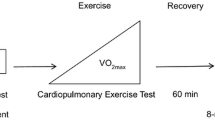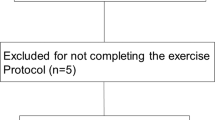Summary
Activation of the sympathetic nervous system plays a major role in the pathogenesis and prognosis of cardiovascular diseases. Rilmenidine is an I1-imidazoline receptor agonist that reduces blood pressure by modulation of central sympathetic activity, but the effects of low-dose rilmenidine on the hemodynamic responses to physiological maneuvers that increase adrenergic drive is not known. To assess the effects of low-dose rilmenidine on the hemodynamic responses to stress, 32 healthy subjects (20–56 years old) underwent acute physical exercise (n = 15, individualized ramp protocol on treadmill) and mental stress (n = 17, word color Stroop and mental arithmetics tests) two hours after the oral administration of 0.5 mg of rilmenidine (RIL) or placebo (PLA) following a randomized, double-blind, placebo controlled crossover study. No subject complained of any side effect. Rilmenidine reduced peak exercise heart rate (PLA: 187 ± 7; RIL: 181 ± 9 bpm; P = 0.003), but did not modify peak aerobic power (VO2max — PLA: 41.7 ± 6.2; RIL: 42.3 ± 6.7 ml/kg/min; P = 0.26). During mental stress, rilmenidine inhibited the peak systolic (PLA: 123 ± 10; RIL: 114 ± 8 mmHg; P = 0.02) and diastolic (PLA: 86 ± 7; RIL: 81 ± 7 mmHg; P <0.05) blood pressure responses. In conclusion, rilmenidine reduced the hemodynamic response to physical and mental stress stimuli without limiting exercise capacity. These results support the concept that rilmenidine, at a dose lower than the ones recommended to treat hypertension, reduced the myocardial oxygen demand to stress and may carry potential clinical impact.
Similar content being viewed by others
References
Brook RD, Julius S. Autonomic imbalance, hypertension, and cardiovascular risk. Am J Hypertens 2000;13(6 Pt 2):112S–122S.
Schlaich MP, Kaye DM, Lambert E, Sommerville M, Socratous F, Esler MD. Relation between cardiac sympathetic activity and hypertensive left ventricular hypertrophy. Circulation 2003;108:560–565.
Julius S, Valentini M. Consequences of the increased autonomic nervous drive in hypertension, heart failure and diabetes. Blood Press 1998;3(Suppl):5–13.
Verrier RL, Antzelevitch C. Autonomic aspects of arrhythogenesis: the enduring and the new. Curr Opin Cardiol 2004;19:2–11.
Curtis BM, O’Keefe JH Jr. Autonomic tone as a cardiovascular risk factor: the dangers of chronic fight or flight. Mayo Clin Proc 2002;77:45–54.
Hjalmarson A. Prevention of sudden cardiac death with beta blockers. Clin Cardiol 1999;22(Suppl 5):V11–15.
De Ferrari GM, Salvati P, Grossoni M, et al. Pharmacologic modulation of the autonomic nervous system in the prevention of sudden cardiac death. A study with propranolol, methacholine and oxotremorine in conscious dogs with a healed myocardial infarction. J Am Coll Cardiol 1993;22:83–290.
Grabe-Guimaraes A, Alves LM, Tibirica E, Nobrega AC. Pyridostigmine blunts the increases in myocardial oxygen demand elicited by the stimulation of the central nervous system in anesthetized rats. Clin Auton Res 1999;9:83–89.
Castro RRT, Porphirio G, Serra SM, Nobrega ACL. Cholinergic stimulation with pyridostigmine protects against exercise induced myocardial ischaemia. Heart 2004;90:1119–1123.
Bousquet P, Feldman J. Drugs acting on imidazoline receptors: a review of their pharmacology, their use in blood pressure control and their potential interest in cardioprotection. Drugs 1999;58:799–812.
Tibiriçá E, Feldman J, Mermet C, Gonon F, Bousquet P. An imidazoline-specific mechanism for the hypotensive effect of clonidine: a study with yohimbine and idazoxan. J Pharmacol Exp Ther 1991;256:606–613.
Tibiriçá E, Feldman J, Mermet C, Monassier L, Gonon F, Bousquet P. Selectivity of rilmenidine for the nucleus reticularis lateralis, a ventrolateral medullary structure containing imidazoline-preferring receptors. Eur J Pharmacol 1991;209:213–221.
Bousquet P, Feldman J, Schwartz J. Central cardiovascular effects of alpha-adrenergic drugs: Difference between catecholamines and imidazolines. J Pharmacol Exp Ther 1984;230:232–236.
Reis DJ, Regunathan S, Wang H, Feinstein DL, Meeley MP. Imidazoline receptors in the nervous system. Fund Clin Pharmacol 1992;6:23S–29S.
Chan CK, Sannajust F, Head GA. Role of imidazoline receptors in the cardiovascular actions of moxonidine, rilmenidine and clonidine in conscious rabbits. J Pharmacol Exp Therap 1996;276:411–420.
De Sarro GB, Ascioti C, Froio F, Libri V, Nistico G. Evidence that locus coeruleus is the site where clonidine and drugs acting at alpha1- and alpha2-adrenoceptors affect sleep and arousal mechanisms. Br J Pharmacol 1987;90:675–685.
Reid JL. Update on rilmenidine: Clinical benefits. Am J Hypert 2001;14(11 Pt 2):322S–324S.
van Zwieten PA, Peters SL. Central I1-imidazoline receptors as targets of centrally acting antihypertensive drugs. Clinical pharmacology of moxonidine and rilmenidine. Ann N Y Acad Sci 1999;881:420–429.
van Zwieten PA. The renaissance of centrally acting antihypertensive drugs. J Hypertens 1999;17(Suppl 3):S15–S21.
Reid JL, Panfilov V, MacPhee G, Elliott HL. Clinical pharmacology of drugs acting on imidazoline and adrenergic receptors. Studies with clonidine, moxonidine, rilmenidine, and atenolol. Ann N Y Acad Sci 1995;763:673–678.
Roegel JC, Yannoulis N, De Jong W, Monassier L, Feldman J, Bousquet P. Inhibition of centrally induced ventricular arrhythmias by rilmenidine and idazoxan in rabbits. Naunyn Schmiedebergs Arch Pharmacol 1996;354:598–605.
Poisson D, Christen MO, Sannajust F. Protective effects of I(1)-antihypertensive agent moxonidine against neurogenic cardiac arrhythmias in halothane-anesthetized rabbits. J Pharmacol Exp Therap 2000;293:929–938.
Mammoto T, Kamibayashi T, Hayashi Y, Yamatodani A, Takada K, Yoshiya I. Antiarrhythmic action of rilmenidine on adrenaline-induced arrhythmia via central imidazoline receptors in halothane-anaesthetized dogs. Br J Pharmacol 1996;117:1744–1748.
Hayashi Y, Kamibayashi T, Maze M, et al. Role of imidazoline-preferring receptors in the genesis of epinephrine-induced arrhythmias in halothane-anesthetized dogs. Anesthesiology 1993;78:524–530.
Catelli M, Feldman J, Bousquet P, Tibirica E. Protective effects of centrally acting sympathomodulatory drugs on myocardial ischemia induced by sympathetic overactivity in rabbits. Braz J Med Biol Res 2003;36:85–95.
Rozanski A, Blumenthal JA, Kaplan J. Impact of psychological factors on the pathogenesis of cardiovascular disease and implications for therapy. Circulation 1999;99:2192–2217.
Panfilov V, Morris AD, Donnelly R, Scemama M, Reid JL. The effects of rilmenidine and atenolol on mental stress, dynamic exercise and autonomic function in mild to moderate hypertension. Br J Clin Pharmacol 1995;40:563–569.
Dollery CT, Davies DS, Duchier J, Pannier B, Safar ME. Dose and concentration-effect relations for rilmenidine. Am J Cardiol 1988;61:60D–66D.
Steptoe A, Vogele C. Methodology of mental stress testing in cardiovascular research. Circulation 1991;83(Suppl. II):II14–II24.
Hayashi Y, Maze M. Alpha2 adrenoceptor agonists and anaesthesia. Br J Anaesth 1993;71:108–118.
Fulgencio JP, Rimaniol JM, Catoire P, Bonnet F. Clonidine and postoperative myocardial ischemia. Can J Anaesth 1994;41:550–551.
Dorman BH, Zucker JR, Verrier ED, Gartman DM, Slachman FN. Clonidine improves perioperative myocardial ischemia, reduces anesthetic requirement, and alters hemodynamic parameters in patients undergoing coronary artery bypass surgery. J Cardiothorac Vasc Anesth 1993;7:386–395.
Thomas MG, Quiroz AC, Rice JC, Sander GE, Giles TD. Antianginal effects of clonidine. J Cardiovasc Pharmacol 1986;8:S69–S75.
Zochowski RJ, Lada W. Intravenous clonidine treatment in acute myocardial infarction (with comparison to a nitroglycerin-treated and control group). J Cardiovasc Pharmacol 1986;8:S41–S55.
Zochowski RJ, Lada W. Intravenous clonidine in acute myocardial infarction in men. Int J Cardiol 1984;6:189–205.
Ceremuzynski L, Zaleska T, Lada W, Zalewski A. Clonidine effect in chronic angina pectoris. Double-blind, crossover trial on 60 patients. Eur J Cardiol 1979;10:415–427.
Giles TD, Thomas MG, Sander GE, Quiroz AC. Central alpha-adrenergic agonists in chronic heart failure and ischemic heart disease. J Cardiovasc Pharmacol 1985;7:S51–S55.
Maki T, Naveri H, Leinonen H, Sovijarvi A. Effect of beta-blocking agents with and without intrinsic sympathomimetic activity on work efficiency in healthy men. Clin Physiol 1996;16:543–550.
Myers J, Prakash M, Froelicher V, Do D, Partington S, Atwood JE. Exercise capacity and mortality among men referred for exercise testing. N Engl J Med 2002;346:793–801.
Laukkanen JA, Kurl S, Salonen R, Rauramaa R, Salonen JT. The predictive value of cardiorespiratory fitness for cardiovascular events in men with various risk profiles: A prospective population-based cohort study. Eur Heart J 2004;25:1428–1437.
Author information
Authors and Affiliations
Rights and permissions
About this article
Cite this article
Teixeira de Castro, R.R., Tibiriçá, E., de Oliveira, M.A.B. et al. Reduced Hemodynamic Responses to Physical and Mental Stress Under Low-Dose Rilmenidine in Healthy Subjects. Cardiovasc Drugs Ther 20, 129–134 (2006). https://doi.org/10.1007/s10557-006-7653-8
Published:
Issue Date:
DOI: https://doi.org/10.1007/s10557-006-7653-8




